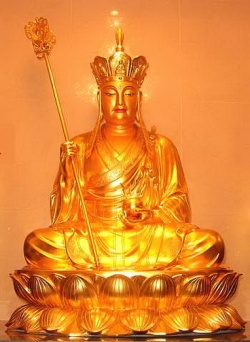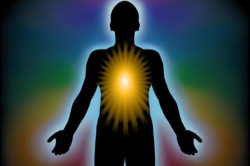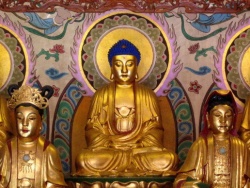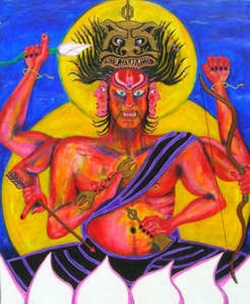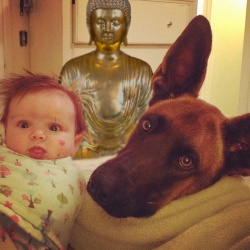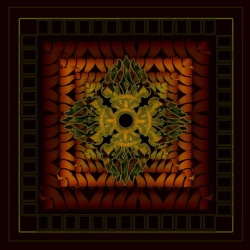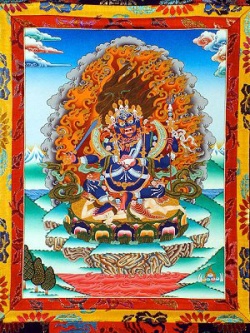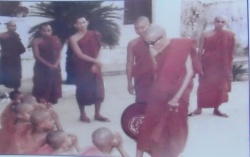Taking emotions as the path
by Tsoknyi Rinpoche III
The Vajrayana says not to reject the kleshas, the negative emotions, but to take them as the path. This can be quite challenging to most people because emotions often govern our body, speech, and mind. So in order to take emotions as the path, we need to take a step back to take a look at emotions.
Where do these emotions come from? The most obvious are the karmic habitual patterns stored in our alaya. We know our own emotional inclinations, these kleshas very well, don’t we? They often seem to be running the show! But sometimes they are confusing; they seem to pop out of the alaya according to very subtle causes and conditions of which we are unaware, not from traceable situations. Other emotions, particularly pure emotions, are not necessarily created by the mind. When these emotions come, they inform the mind and create moods that color everything. Some emotions are simply patterned into the physical system. So when the physical system is triggered, those emotions come up in the mind. For example preliminary practice, ngöndro, is a time when a lot of emotions can be triggered due to the physical activity. Some people cope well with it, but some cannot take it, so preliminary practice can be a very emotionally challenging time.
However, it’s not only special practice situations that produce strong emotions in the body’s chemistry. One that most people experience is fear. There are two kinds of fear. The first is a healthy fear, like when you are walking and suddenly feel yourself tripping. Fear arises instantly as a bad taste in your mouth; you can taste the chemistry of fear. Until you become a rainbow body you need that fear. That fear is part of our relative-truth wisdom. If you see a car coming straight at you, you need to do something with your intelligence and clarity. Is jumping to the side best? But which side? Is rolling out of the way better? Or is it best to stand still and wave your arms, so the car can see you and go around you? At that moment you have to choose to do something to protect your physical body. When you’re a rainbow body, then you can think, “Oh yeah, this body is transparent, it cannot be harmed, so it’s not an obstruction.” Until then, you need this fear because it will lead to life-saving action.
The other fear is an unhealthy fear, a deluded fear that feels like a constant buzz in our body and mind. This is the fear you need to take care of. With such strong emotions like deluded, solidified fear I suggest you start by developing an attitude towards it that views it neither as an enemy to be abandoned, nor as something with which to identify. Once this attitude is established, bring the emotion into focus. Emotions like fear are misperceptions by the ego and result in mental grasping. Because there is grasping, a good aikido-welcome works well with it. An aikido-welcome releases mental/emotional grasping just like it does physically. You begin by saying, ”Oh hello fear, I see you’re here, but that’s okay because there’s room for you.” Then, as you relax the subtle body the fear itself relaxes a bit. At this point, like in aikido, you can move the energy of fear more easily in the same direction you are going because the ego’s fear-story is no longer in charge of the energy. By applying this method you are beginning to take emotion as the path. What is the key to doing this? It is removing the ego’s attachment to the fear story.
This is how you can approach anger as well. There are two kinds of anger. One comes from believing you are right. It is a pure anger, not really sticky. With it comes a lot of clarity and, for the practitioner, the possibility of mirror-like wisdom, the dissolving of anger and ego in rigpa.
But there is another kind of anger that comes when you feel you have been wrong, made mistakes or avoiding feeling of self-blame…“I’m not wrong!” This sort of anger is more difficult to deal with because it has a lot of delusion connected to it and is not so clear. It is stickier than the pure anger. This is the anger you need to take care of. It can be very powerful, heating up the physical body, tightening the subtle body, and narrowing the conceptual mind’s focus to just the object seen as threatening and the source of anger. When this anger arises, it’s ordinarily experienced as something solid and is filled with ego because within the emotions are the five poisons. Within all of the five poisons, there is one predominant element, the ego that clings to experiences and to its own survival. You have to abandon this ego, no matter what. Remove ego and the five poisons become transformed to the five wisdoms.
Actually, ego is happy when you notice it and challenge it. It likes the focus; it likes the attention. It’s used to being the center of your universe and a challenge makes it feel so important, and, if it is invested in being a practitioner, so spiritual, so holy. This is why first welcoming emotion and then turning away is quite upsetting to ego. The aikido-like moves transform the energy that supports the ego’s story and centrality in your life. When the energy is transformed, ego doesn’t know what to do. When the ego doesn’t know what to do, it freaks out and that is the time to recognize rigpa, if you can. But sometimes it’s difficult to recognizing rigpa when the kleshas are strong, so this aikido-like method works well even if you cannot rest in rigpa. In fact, when any obstacle comes, any emotion comes, the aikido method works best. But first you must welcome it. Do not confront, just welcome. But don’t hang out too long with it. If you do, you are likely to merge with the emotion and that is quite different then doing the aikido moves. Technically you may understand this, but whether you can do it or not depends on your skill in practicing this way. So practice the skill of “mental aikido” because it is very useful.
So what else can you do with self-blaming anger? It has both emotional and mental aspects that need to be dealt with, but before doing either of those, it’s best to take care of the emotion in your physical body. Generally I don’t recommend that Westerners do Tibetan Buddhist body practices. Your complex life produces subtle restlessness (lung), an emotional problem we don’t commonly see in traditional Tibet society. In Tibet they assume you don’t have a problem with restlessness and teach a lot of jumping, a lot of breathing. Sometimes it’s too much for Westerners and you might get more restlessness. Instead, I think westerners should go more in the direction of yoga, tai ji or qigong.
However, there are some meditative practices in the Tibetan system that can be very helpful. In the Tibetan system we understand that there is a subtle body made of tsa, lung and tigle. The Tibetan word tsa is called nadi in Sanskrit and translates as channels in English. The Tibetan word lung is prana in Sanskrit and translates as energies or winds in English. Tigle is bindu in Sanskrit or seeds of energy in English. Within the subtle body there are different levels of subtlety. The channels are the most gross, the energies are subtler, and finally the seeds of energy are quite subtle. So meditation practices involving exercises for tsa, lung, tigle are a way of working with the subtle body and are used when taking emotions as the path. But you need to know the right way to do these exercises otherwise they will not function correctly. Because of the lung problem, you need to take your time, scan your body and loosen up the energetic knots. Over the years, knots of restlessness have developed and underneath the restlessness is ego. But ego does not like to let go, so it takes a few months, a few years perhaps, to really let go. So before you try to practice Tibetan tsa-lung exercises, I think it’s good to practice jam-lung, subtle vase breathing. Anything harsh does not work for the western body, but a very long time of gentle nurturing opens it up and the subtle body begins to rejuvenate.
Once the subtle body begins to rejuvenate you can bring in mental understanding, the second aspect generally needed to work with strong emotions. A good practice for this is The Four Applications of Mindfulness. They begin to break down the ego clinging that makes self-blaming anger so powerful. Breaking down the ego clinging makes it possible to reconnect with the spark of love that lives within all of us. This spark, this basic love has surely been obscured if there is self-hatred. Basic love has been replaced by a very critical ego. Generally, you’ll find that your expectations for your life have been set so high that you are bound to be disappointed with yourself. But once you feel the spark of basic love again, really feel it, it’s possible to adjust your expectations for your life. Only then can well being infuse your heart. If you don’t do this, you’ll continue to suffer greatly from self-blaming anger. However, if you begin to receive the nurturing of basic love, your mind becomes more stable, and it’s not as hard take the medicine of rigpa.
Using rigpa medicine can bring a klesha to an extreme and at its peak realize its emptiness. However, rigpa medicine also works well without letting the emotion build. If you can, go directly to the view of rigpa, seeing the empty, spacious nature of the emotion, without rejecting, avoiding or having to transform it. Within rigpa, the anger ceases to be solid. By realizing emptiness and resting in rigpa, the already weakened ego-clinging dissolves. With no self to be hit by the emotion, there is no need to reject the anger or react to it. The counterpart of anger is mirror-like wisdom and this will come as you experience the pure energy of anger. When there is the experience of anger’s pure energy, it enhances clarity of mind. That enhancement of the clarity stays as rigpa clarity. And that is the quality of mirror-like wisdom that sees everything.
But these methods are quite difficult to do because they require strong, stable rigpa and this takes some time to establish. So that is why I recommend beginning with the wisdom of the aikido-like method. However, no matter which combination of practices you use to let go of the anger story, you need to know that anger leaves some sensation in the body and you might think anger is still there. Don’t be confused by this, because actually the anger is gone. As long as the ego is not grasping, the feeling will no longer produce any karmic pattern. It’s just an uncomfortable feeling that can distract you if you don’t see it as just a little bit of physical discomfort. Don’t hook back into it. It takes some time to cool down, but the emotional part of anger is gone as soon as you let go of the ego grasping. Only the energy is left, and that is what the body is feeling.
It is incomplete to look at emotions as the path for western Vajrayana practitioners without considering depression. For many, many Westerners depression is a life-long emotional struggle, with much suffering, and I think it’s connected with tigle (bindu), the seeds of energy. When I discuss depression with people, they say the experience is one of no light in their life; their thoughts and bodies feel heavy and hollow; there’s no enthusiasm, and their sexual desire has gone down (although they may not behave this way). Everything is gray or even black and they are easily scared (again, they may not behave this way). They feel flat and there’s no “juice.” Anything connected with bliss is gone.
This is very close to the description of what happens in our constitution when the energies are blocked and the tigle cannot move freely throughout the body. The tigle are stuck in one place and start to diminish. When they diminish or dry up, minds start to feel a sense of depression. When not dried up and the subtle body is in balance, tigle function as the basis for love, happiness, compassion, and bodhicitta. Usually the mind rides on these energies, but when the energies become too speedy, our minds fill with worry and anxiety. Speed itself can go in a positive way or a negative way, but when it drives our minds in a negative way our whole system feels the impact. When this energy comes into the heart, people can become quite depressed and hopeless. I call this “chicken-hearted,” and it’s another form of depression. No matter what the specific formative circumstances, people with depression are easily overwhelmed by stimulation and just want to pull the covers over their head. Without the courage or guts to engage in life, they become ruled by fear and aversion and either take no risks or are covering it up with bravado.
From the practice perspective, the tigle need to be revived. In the beginning, it’s difficult to address the tigle directly, so we start by working with our minds, which are usually full of thoughts of all kinds. Having a lot of thoughts also can dry up the strength of the tigle. Therefore we train our minds to calm down, relax and remain still through the practice of samadhi. If you can do this, it automatically rejuvenates the tigle, bringing back the experience of well-being. You can also apply the Four Applications of Mindfulness as we saw with anger. They too will stimulate a sense of well-being. Another important method you can apply to depression is intellectual conviction. Although you feel lousy, your conceptual belief can be quite strong. You trust the Dharma, the blessings of your teacher, and the lineage teachers. Based on this trust, you should supplicate the teachers and receive their spiritual influence. These blessings impact your subtle body and you start to experience well-being again. All of these methods can be used to jump start the tigle.
Once the tigle begin to move again, your desire and enthusiasm begin to come back. Then it helps to “feed” the tigle with things that nurture well-being, like stable, emotionally healthy relationships, good food, beauty, music, and the juicy practices like devotion, which bring bliss and joy. But of course you have to take care. You have to take care of your energy. You have to use it the right way. When desire and enthusiasm come, don’t exhaust yourself expending it in the next moment. But eventually enthusiasm, bravery, openness, juiciness, compassion, love, and bliss–many things come together.
From the Vajrayana point of view, emotions are fine. But if you use them wrongly, these emotions can be harmful. The key to the Vajrayana approach is remembering that your emotions are your emotions, whether you are skillfully managing them or not. They are your production. They are all empty in nature. Because of this, all emotion in Vajrayana is welcomed as method. But in Vajrayana practice, any emotional feeling can be mistakenly indulged if there is not sufficient wisdom and stable rigpa. Then it becomes just craziness or harmful behavior. This is important, so make sure your practice is a balance of wisdom and method. You need to know how to welcome emotions. It doesn’t mean you follow them all the way. Opening the door to them completely is the samsaric way of welcoming, not the Vajrayana. If you follow any emotion completely, it does not lead to freedom.
However, once you have a stable rigpa practice, you can let go of all methods because recognizing the view is the best way of dealing with emotions. Just recognize rigpa, realize emptiness. That’s all. When any emotion comes, just re-recognize rigpa, realize emptiness. The emotions will naturally become purified. With stable rigpa, emotions can be purified through liberation, using self-liberation, liberation upon arising or liberation without benefit or harm. But if there’s still some lingering negative emotion, although rigpa is totally stable, it is fine to say: “Oh, hello, I am sorry, I didn’t know you were still here.” Make a “handshake” with what is hanging around, engage with it so the emotion doesn’t feel left out. You can include the emotion with an “Oh honey.” Just say “honey” like a sweet mantra. It doesn’t mean much because you are no longer trapped by the ego’s attachment to emotion, but the ego will be happy…and then you can continue to practice!
.The particular method of Dzogchen is called the Path of Self-Liberation, and to apply it nothing need be renounced, purified, or transformed. Whatever arises as one's karmic vision is used as the path. The great master Pha Tampa Sangye (South Indian Yogin of the 11 century (ed.)] once said: It is not the circumstances which arise as one's karmic vision that condition a person into the dualistic state; it is a person's own attachment that enables what arises to condition him. If this attachment is to be cut through in the most rapid and effective way, the mind's spontaneous capacity to self-liberate must be brought into play. The term self-liberation should not, however, be taken as implying that there is some 'self' or ego there to be liberated. It is a fundamental assumption...at the Dzogchen level, that all phenomena are void of self-nature. 'Self -Liberation', in the Dzogchen sense, means that whatever manifests in the field of experience of the practitioner is allowed to arise just as it is, without judgement of it as good or bad, beautiful or ugly. And in that same moment, if there is no clinging, or attachment, without effort, or even volition, whatever it is that arises, whether as a thought or as a seemingly external event, automatically liberates itself, by itself, and of itself. Practicing in this way the seeds of the poison tree of dualistic vision never even get a chance to sprout, much less to take root and grow.(p33)
So the practitioner lives his or her life in an ordinary way, without needing any rules other than one's own awareness, always remaining in the primordial state through integrating that state with whatever arises as part of experience -- with absolutely nothing to be seen outwardly to show that one is practicing. This is what is meant by self-liberation, this is what is meant by the name Dzogchen - which means Great Perfection - and this is what is meant by non-dual contemplation, or simply contemplation....
piritual Practice
The Raw Feeling
Thoughts arise spontaneously and we are not the source of the thoughts. We did not generate the thoughts, check the thoughts, approve of them and finally publish them. No - the thoughts just come. If we try and stop a thought - it comes anyhow. The thought generator in the head is very active and persistent.
If we could control our thoughts, if we caused them - we could stop certain thoughts and only have happy thoughts from now on. But it does not work out that way. Thoughts can be suppressed, but they were already thoughts before they were suppressed. And they come back.
Feelings arise spontaneously and we are not the source of the feelings. We do not generate the feelings, check to see if they are correct or appropriate and finally release them if they are OK. It does not work out like that with feelings too. Feelings arise - feelings that are "not good" but they do not leave straight away.
We do not cause thoughts or feelings - for the simple reason is that there is not an "us" there to bring them about. Our nature is universal, eternal and not personal. No-one there to create thoughts and feelings.
Our true nature - Aliveness - Awareness - Consciousness - is there through all thoughts and feelings. How else could we be aware of thoughts or "feel the feelings". Our nature is not in any was reduced by so-called "bad" thoughts or feelings. Consciousness is there - Aware of it all. Nothing is rejected.
Along comes conceptual thought to us at about 2 or 2.5 years of age. Pretty soon there is a concept of "me" and lots of other concepts as well.
As we grow older more and more concepts are generated. It is not that concepts do not have their place - they do - but in the spiritual quest that is not the case. The spiritual quest is not "sorted" by the mind or concepts.
Feelings that occur are conceptualised. A feeling comes up - at this stage it is the raw feeling - at this stage the feeling is non conceptual. The feeling is felt but there is initially no labeling. Just the raw feeling.
Very quickly a label is applied to the feeling. The words used may be "anger", "fear", "anxiety" or whatever. But the actual feeling - the raw one - is not a concept like these. The conceptualising seems to "cut us off" from the original actual raw feeling (in reality it does not do this). As we grow older the label is applied with increased speed so the amount of time experiencing the raw feeling seems to be reduced and reduced.
What is it like to experience the raw feeling? It is easy to do - in fact it is happening all the time - so there is nothing that you need to do at all. The initial perception of a feeling is always raw. Even when labels have been applied, the raw feeling is still there being perceived in the immediacy of the present moment.
You can notice the raw feeling, with no thought at all. Casually looking at the raw feeling. Once again, although it is expressed in these terms, nothing is happening that is different to what is always happening.
The raw feeling can feel like a movement of energy (best description) , a buffeting, a turbulance, a pressure or heaviness - or many others - but even these are in the realm of concepts being applied to the feelings. Just look at the feeling without thought and without conceptualisation (which also means no thought).
Looking at the real - the raw feeling - the mind slows down or stops. But this is not "mind control". It just happens. There is something very special about seeing the Real. We do not do it very often - maybe it is a shock to the system ! (joke)
Cats do it all the time. Dogs too.
Resist the urge to label the raw feeling, describe it, or explain it. If labels, judgments, descriptions or any other thoughts occur - just let them pass through. No-one there taking delivery of them, as Bob Adamson says.
Once again the pure perception always occurs and there is no labeling, describing or explaining. The usual deal is that the mind comes in and does all that, but it is always after the perception.
The raw feelings can change and morph while you are looking at them, or they can stay exactly as they are. It is very interesting.
Sometime the raw feeling will disappear completely (and not come back) and be replaced by a sense of joy, excitement or exhilaration. This sense of joy was in fact there all the time - and is your own true nature. It is always there, even if not noticed. It is the smile on The Buddha's face.
Sometimes the raw feeling will change when you look at it and move partially away and a feeling of Aliveness and excitement can be felt underneath it. This is difficult to describe - and words are always dualistic. Then the raw feeling may come back and at the same time the Aliveness feeling is there as well (as it always is).
Sometimes the feeling can feel like a movement of raw energy, but that movement changes in the way it moves, and in its intensity.
In doing this you are not being the "watcher" or the "witness", which are conceptualisations after the fact. All that is occurring is what always occurs, but may not have been noticed.
This is not done as a strategy, a method of getting rid of the feeling. There is no ultimate purpose for it and actually nothing is being done at all. It is not an investigation, not something that will build up your knowledge. Just a looking.
It is different every time and you cannot compare this time with the last - as this is just conceptualising it all again.
Only ever in this moment. Only a looking. It is not "you" looking - it is just looking occurring.
The feeling moves on - meaning the raw feeling - in its own time. It is not "our" feeling and never was. It may implode immediately or hang around for a day or so.
You may not notice the raw feeling go and only realised some time later that it has gone. Sometimes the raw feeling may suddenly disappear like the finale of a fireworks display.
The raw feeling is not a problem at all. In fact it is just sensation and can be quite interesting and even sensual.
The feeling is only a problem when it is conceptualised and when a story is woven around the feeling ("me" and my story). But all of this is in addition to the actual. It is the added conceptuality of the "me", the conceptual labels, and of course the story - which is conceptual. So just stick with the real - the raw feeling.
This is not to say that the raw feeling will not be painful. Pain is actual - it is real - but the pain can be conceptualised too, and story woven into it. So if the pain is there - just stick with that - do not multiply the pain with layers of conceptualisation on top of it.
Interestingly, the story does not run with the raw feeling. The story needs the conceptualisation (of the raw feeling) , which is the trigger into the mindstream.
As the conceptualisation of the feeling starts to fall away the perception of the original raw feeling may very well be enhanced. There is now no veil of conceptualisation there, which appeared to have a "deadening" effect on perception.
Sticking with the raw feeling is very interesting and good fun. All that is actually there (leaving out mind content, of course) is the raw feeling and Consciousness itself.
Normally both are conceptualised, but when the feeling is not conceptualised, the conceptualisation about our own nature can fall away too.
Very often it is amazingly clear, by direct experience, that "we are not the perceived - we are that which perceives ".
At that point the mind shuts down of itself.
